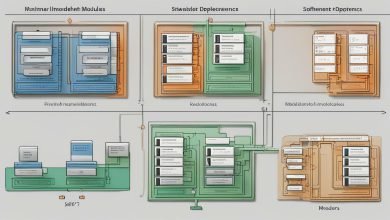
Welcome to this guide on Service-Oriented Architecture (SOA)! In today’s fast-paced technological landscape, businesses require IT systems that can quickly adapt to changes in their environments. SOA is a design approach that offers a flexible and efficient way of integrating software applications and infrastructure. In this guide, we will explore the key principles and benefits of SOA. We will also provide insights into its implementation and integration within IT frameworks.
Key Takeaways:
- Service-Oriented Architecture (SOA) is a design approach that facilitates efficient integration of software applications and infrastructure.
- SOA offers benefits such as scalability, reusability, and interoperability in IT systems.
- The principles of SOA include loose coupling, service reusability, and service composition.
What is Service-Oriented Architecture (SOA)?
Service-Oriented Architecture (SOA) is a design methodology for creating flexible and scalable software systems. The architecture is based on the concept of services that communicate with each other to perform specific tasks. These services are designed to be loosely coupled, which means they can be modified and updated independently of other services.
SOA architecture is built around the idea of modular design, allowing for easier maintenance and updates. This approach enables businesses to streamline their IT frameworks, leading to enhanced efficiency and cost savings.
SOA Design Patterns
SOA design patterns are standardized solutions to common software design problems. These patterns can be used to create software systems that are more scalable, flexible, and maintainable.
Some common SOA design patterns include the Service Broker pattern, which uses a central service broker to route messages between services, and the Event-Driven Messaging pattern, which allows services to communicate asynchronously through the use of events.
SOA Web Services
SOA web services are a set of standards and protocols for creating and integrating services in an SOA environment. These services use the XML language to communicate with each other, allowing for interoperability between different platforms and technologies.
SOA web services can be designed to be stateful or stateless, depending on the requirements of the system. Stateless services are simpler and more scalable, while stateful services can maintain a session with the client, allowing for a more personalized experience.
SOA architecture, design patterns, and web services are the building blocks of modern software systems. By implementing a service-oriented approach, organizations can create more flexible, scalable, and efficient IT frameworks.
Benefits of Service-Oriented Architecture (SOA)
Implementing Service-Oriented Architecture (SOA) offers a wide range of benefits for modern IT solutions. SOA is designed to enhance scalability, flexibility, and reusability, which are major concerns for companies operating in a dynamic business environment. Here are some of the key benefits of SOA:
- Improved Scalability: One of the most significant benefits of SOA is its ability to scale up or down to meet changing business needs. Services can be added or removed as necessary, ensuring that the system remains responsive and cost-effective.
- Increased Reusability: SOA promotes the reuse of services, which can lead to faster and more efficient development cycles. Services can be used in multiple applications and projects, reducing the need for redundant development efforts.
- Enhanced Interoperability: SOA enables seamless communication between different systems and applications, regardless of the platform or programming language used. This makes it easier to integrate legacy systems and third-party services into new solutions.
- Greater Flexibility: SOA provides a flexible architecture that allows developers to respond quickly to changing business requirements. Services can be modified or replaced without affecting other parts of the system, making it easier to adapt to new market conditions.
- Increased Efficiency: SOA reduces the complexity of IT systems by breaking down applications into smaller, reusable components. This streamlines development and maintenance efforts, reducing costs and improving system efficiency.
By leveraging these benefits, companies can create more agile and efficient IT solutions that are better suited to the demands of the modern business environment. From improved scalability to increased efficiency, SOA offers a wealth of solutions that can help businesses stay competitive in a rapidly changing market.
Principles of Service-Oriented Architecture (SOA)
Service-Oriented Architecture (SOA) is governed by a set of key principles that guide its implementation. These principles ensure that services are designed to be reusable, interoperable, and loosely coupled, which are essential for creating efficient and effective IT frameworks.
Loose Coupling
One of the primary principles of SOA is loose coupling, which means that services are designed to be independent of each other, and changes in one service do not affect others. This allows for greater flexibility and agility in IT frameworks, as services can be updated or replaced without disrupting the entire system.
Service Reusability
Another key principle of SOA is service reusability, which allows services to be used in multiple applications or systems. This reduces duplication of effort and promotes consistency across the IT framework. By designing services to be reusable, organizations can also reduce development costs and improve time-to-market for new applications.
Service Composition
Service composition is a principle of SOA that involves combining multiple services to create a new, composite service. This enables organizations to create new services quickly and efficiently by leveraging existing ones. It also allows for greater flexibility and scalability in IT frameworks, as new services can be added or removed as needed.
By adhering to these principles, organizations can build IT frameworks that are efficient, flexible, and scalable. SOA can help organizations achieve their business goals by improving the reusability, interoperability, and scalability of IT systems.
Implementing Service-Oriented Architecture (SOA)
Implementing Service-Oriented Architecture (SOA) can bring significant benefits to IT systems. However, it’s important to follow best practices to ensure successful implementation and avoid common pitfalls. Here are some key steps to consider:
Service identification
The first step in implementing SOA is identifying the services that will form the foundation of an SOA framework. Services should be defined based on the business needs and objectives, and should be designed to be reusable across different application domains. It’s important to have a comprehensive understanding of business processes and requirements to identify the right services.
Governance
SOA governance is a critical aspect of successful implementation. It involves defining policies and guidelines for managing services throughout their lifecycle. Governance should cover aspects such as service discovery, provisioning, testing, deployment, operations, and retirement. A well-defined governance model can ensure that services are developed and managed consistently and effectively.
Monitoring
Proactive monitoring of SOA services and components is essential for ensuring the performance, availability, and reliability of the overall system. Monitoring should cover aspects such as service usage, response times, errors, and capacity. It’s important to use appropriate monitoring tools and techniques to identify and address issues quickly.
Service composition
Service composition involves combining individual services to create higher-level services that meet specific business requirements. It’s important to design service compositions carefully to ensure scalability, flexibility, and maintainability. Service compositions should be modular and loosely coupled, allowing for easy modification and reuse.
By following these best practices, organizations can successfully implement Service-Oriented Architecture (SOA) and take advantage of its many benefits.
Integration in Service-Oriented Architecture (SOA)
Integrating different systems and services is crucial to the success of Service-Oriented Architecture (SOA). By integrating systems and services, organizations can enhance their operational efficiency and reduce costs. SOA integration involves the use of middleware, which acts as an intermediary between various systems and services.
SOA integration is not a one-time activity but an ongoing process that requires continuous monitoring and optimization. The integration needs to be implemented in a manner that ensures seamless communication and interoperability between services and systems. This is achieved by adhering to SOA principles such as loose coupling and service autonomy.
| SOA Integration Best Practices: |
|---|
| 1. Use a centralized repository for services metadata. This enables better governance and reuse of services. |
| 2. Implement message-based communication. This ensures asynchronous processing and reduces coupling between services. |
| 3. Use protocols that support interoperability. This enhances the ability of services to communicate with each other. |
The success of SOA integration depends on the ability of organizations to effectively identify services and systems that need to be integrated. It is also important to ensure that the integration process is aligned with the overall business objectives. The governance and monitoring of the integration process play a critical role in ensuring the successful implementation of SOA integration.
By following best practices and adhering to SOA principles, organizations can achieve a seamless integration of services and systems, enabling them to respond quickly to changing business needs and achieve increased agility and efficiency. SOA integration is an essential element in the development and implementation of modern IT frameworks.
Design Patterns and Frameworks in Service-Oriented Architecture (SOA)
Service-Oriented Architecture (SOA) can be complex, but design patterns and frameworks provide essential guidelines to simplify the development process. These models establish common structures that can be reused across multiple projects, reducing development time and improving overall quality.
SOA Design Patterns
SOA design patterns offer a set of proven solutions to common problems that arise during the development of SOA solutions. By applying these patterns, developers can avoid reinventing the wheel and instead focus on the unique aspects of their project.
One of the most widely used SOA design patterns is the Service Registry pattern. This pattern provides a central registry where services can be published and discovered by various applications within the SOA environment.
Another popular SOA design pattern is the Service Gateway pattern. This pattern acts as a single entry point to a set of services, providing security and routing capabilities to the various clients that access these services.
SOA Frameworks
SOA frameworks are pre-built infrastructures that provide a set of tools and services to support the development and deployment of SOA solutions. These frameworks offer a standardized approach to building and managing SOA solutions, making it easier to scale and maintain complex applications.
One of the most widely used SOA frameworks is Apache ServiceMix. This framework provides a set of tools for integrating, managing and monitoring services within an SOA environment. It also supports multiple communication protocols and can be extended to support various programming languages and platforms.
Another popular SOA framework is WSO2. This framework provides a scalable and flexible platform for developing and managing SOA solutions. It includes a set of tools for service development, governance, and monitoring, as well as support for a wide range of protocols and data formats.
Implementing design patterns and utilizing frameworks can greatly improve the development process and ensure the success of an SOA project. By adhering to established design principles and utilizing proven tools, developers can focus on delivering high-quality services and applications that meet the needs of their organization.
Web Services in Service-Oriented Architecture (SOA)
Web services are a fundamental component of Service-Oriented Architecture (SOA), enabling the integration of disparate systems and services. At the heart of web services in SOA are standards such as SOAP, REST, and XML, which provide a common language for communication between services.
SOAP (Simple Object Access Protocol) is a messaging protocol that defines the format of messages exchanged between web services. REST (Representational State Transfer) is an architectural style that uses HTTP for communication between services. XML (Extensible Markup Language) is a markup language that provides a standardized format for data exchange between web services.
Web services in SOA provide a modular and scalable approach to system integration. By encapsulating functionality in a service, it becomes reusable across multiple applications and platforms. This improves the agility and flexibility of IT frameworks, as services can be easily replaced or updated without disrupting other systems.
Another benefit of web services in SOA is the ability to expose functionality to external parties. This opens up new opportunities for collaboration and innovation, as external parties can leverage existing services to build new applications or extend existing ones.
SOA Web Services Best Practices
When implementing web services in an SOA environment, it is important to adhere to best practices to ensure optimal performance and security. Here are some best practices that can be followed:
- Keep services granular: Services should be designed to provide a single, well-defined function. This makes them more reusable and easier to manage.
- Use versioning: Services should be versioned to allow for changes without breaking existing clients.
- Use security standards: Web services should be secured using standards such as WS-Security or SSL to protect against unauthorized access.
- Implement service governance: Service governance provides a framework for managing and monitoring services, ensuring they are aligned with business goals and objectives.
By following these best practices, organizations can maximize the benefits of web services in an SOA environment.
Conclusion
Service-Oriented Architecture (SOA) is a valuable concept that can improve the efficiency and flexibility of modern IT frameworks. Through loose coupling, service reusability, and service composition, SOA offers a multitude of benefits, including enhanced scalability, reusability, and interoperability.
Implementing SOA requires careful planning and execution, with best practices such as service identification, governance, and monitoring playing a critical role in successful implementation. Furthermore, the use of design patterns and frameworks, as well as web services, further promotes best practices in developing SOA solutions.
As we conclude this guide on SOA, we encourage readers to explore the potential of this approach in their organizations. By adopting SOA principles and best practices, businesses can optimize their IT frameworks and enhance their operations for the long term.
FAQ
Q: What is Service-Oriented Architecture (SOA)?
A: Service-Oriented Architecture (SOA) is an architectural approach that emphasizes the creation of modular, loosely coupled services that can be easily consumed and combined to build applications. It involves designing and implementing services that perform specific functions, communicate with each other through service interfaces, and can be reused across different applications.
Q: What are the benefits of Service-Oriented Architecture (SOA)?
A: Service-Oriented Architecture (SOA) offers several benefits, including improved scalability, reusability, and interoperability. By creating services that can be reused across different applications, organizations can reduce development time and costs. SOA also allows for easier integration of disparate systems and provides the flexibility to adapt and evolve applications as business needs change.
Q: What are the principles of Service-Oriented Architecture (SOA)?
A: The principles of Service-Oriented Architecture (SOA) include loose coupling, service reusability, and service composition. Loose coupling ensures that services can be developed and deployed independently, allowing for flexibility and modularity. Service reusability promotes the creation of services that can be easily reused across different applications, reducing development efforts. Service composition involves combining multiple services to create complex, higher-level functionalities.
Q: How do you implement Service-Oriented Architecture (SOA)?
A: Implementing Service-Oriented Architecture (SOA) involves several steps. It starts with identifying the services needed and defining their interfaces. A governance framework should be established to manage and govern the services throughout their lifecycle. Monitoring tools can be implemented to ensure the performance and availability of the services. Best practices for successful SOA implementation include thorough service identification, effective governance, and continuous monitoring.
Q: How does integration work in Service-Oriented Architecture (SOA)?
A: Integration in Service-Oriented Architecture (SOA) involves connecting and coordinating various systems and services within the architecture. Different integration methods and techniques, such as messaging queues, service buses, and application programming interfaces (APIs), can be utilized to enable communication and data exchange between services. Integration is crucial to achieving the interoperability and flexibility that SOA offers.
Q: What are design patterns and frameworks in Service-Oriented Architecture (SOA)?
A: Design patterns and frameworks in Service-Oriented Architecture (SOA) provide standardized approaches and guidelines for designing and implementing SOA solutions. They promote best practices and help developers create efficient and reusable services. Examples of design patterns in SOA include service orchestration, service choreography, and event-driven architecture. Frameworks like Apache Axis and WSO2 provide tools and libraries that simplify the development and deployment of SOA applications.
Q: What role do web services play in Service-Oriented Architecture (SOA)?
A: Web services are a key component of Service-Oriented Architecture (SOA). They allow services to communicate and interact with each other over a network using standardized protocols and formats such as SOAP (Simple Object Access Protocol) and XML (eXtensible Markup Language). Web services provide the foundation for integrating disparate systems and enable the interoperability and flexibility that SOA offers.







